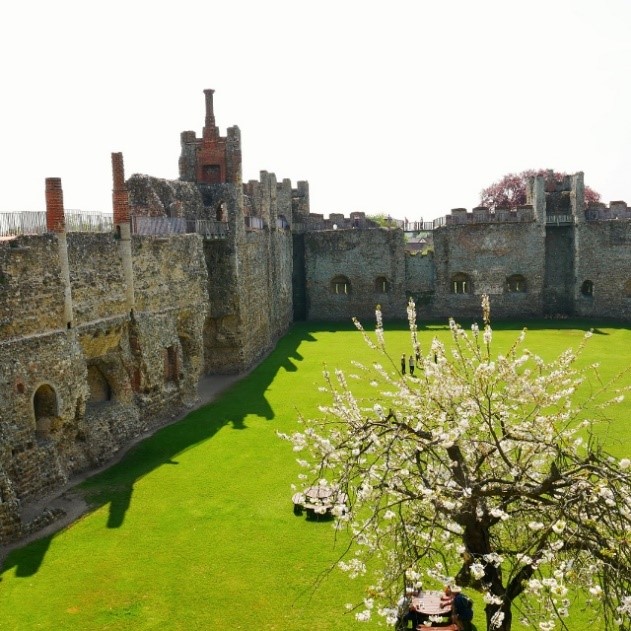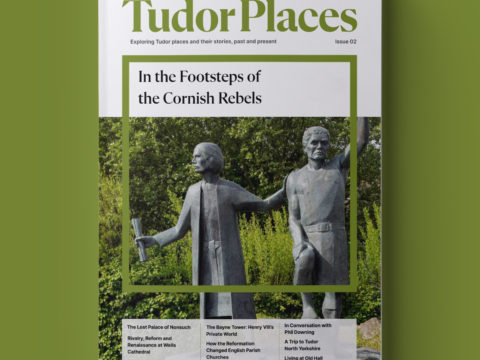Framlingham Castle
A stunning fortress in delightful countryside
Chapter 2 : The Bigods
There was an early Saxon settlement at Framlingham, evidence for which was discovered in the 1950s when a graveyard was found near the entrance to the castle.
Following the Norman Conquest, the land was held by Hugh d’Avranches, Earl of Chester, one of William the Conqueror’s barons-in-chief. He gave tenure to Roger Bigod, who was granted the manor directly by Henry I in 1101.
Roger’s son, Hugh Bigod (d. 1177), was created Earl of Norfolk by King Stephen in 1140, although his loyalty to the king was not entirely consistent – he joined the Empress Matilda, Stephen’s rival for the throne in 1141. Matilda confirmed his earldom. This switch of allegiance paid off in 1154 when Matilda’s son, Henry FitzEmpress, became King Henry II.
Henry II was on a mission to curb the power of the barons who had run amok during the years of the civil war, and, although Hugh’s title was confirmed, some of his lands were confiscated, including Framlingham, by then with some early stone buildings. Framlingham was restored to the Bigods in 1165, but lost again when Hugh raised a rebellion.
Richard I re-granted the earldom and Framlingham, amongst other territories, to Roger Bigod II (d. 1221) in 1189, and it was this Earl Roger who built the walls we see today. Earl Roger and his son were the first two signatories of Magna Carta.
King John was not the man to stand for such humiliation, and, following his resurgence after the low point of the Magna Carta, he attacked Framlingham, which surrendered almost immediately. After a suitable period of punishment, Bigod again took possession of his castle, but died in 1221, followed, in 1225, by his son Hugh Bigod II. This left the inheritance in the hands of Roger Bigod III whom Henry III recognised as 4th Earl of Norfolk in 1233.
The 4th earl not only inherited the Bigod estates, but a vast landholding in South Wales and Ireland from his mother Maud Marshal. Maud’s father, William Marshal, 1st Earl of Pembroke, had been the most influential man in England during the late thirteenth century, fighting for both Richard I and King John. Subsequently, he became regent during the boyhood of Henry III. All of Maud Marshal’s brothers died without children, so his office of Marshal to the king devolved on Roger.
During the Barons’ Wars of the 1250s, Bigod supported Simon de Montfort against the king, but managed to retain his East Anglian lands. He was married in 1225 to Isabella, the sister of King Alexander II of Scotland, but they had no children. Whether the childlessness was the result of an unhappy marriage, or the cause of Roger’s attempts to have it annulled in 1245, is unknown. He requested annulment on the grounds of consanguinity, but the Pope refused, and in 1253, the couple were commanded to live together again.
Having no children, Roger III’s heir was his nephew, Roger Bigod IV, who became Earl of Norfolk in 1270. Roger IV expended money liberally, both at Framlingham, where new lodgings were built and extensive repairs made to the stonework, and also at his estates in Wales. The new interiors were fit for the royal visit Roger received in 1277, when Edward I stopped at Framlingham en route to the shrine of Our Lady of Walsingham.
Initially heavily involved in Edward I’s campaigns in Wales, Bigod later quarrelled with the king, pointing out that his feudal tenure only obliged him to fight when the king was actually present. The famously wrathful Edward I threatened to have Bigod hanged, but the earl braved it out. This quarrel, together with the huge debts Bigod ran up improving Framlingham and Chepstow Castle created a financial crisis which resulted in the childless Bigod surrendering his earldom, to have it regranted with remainder (ie inheritance rights) only to heirs of his own body. This had the effect of disinheriting his siblings and their offspring and meant that when he died in 1306, his territories escheated to the crown.







